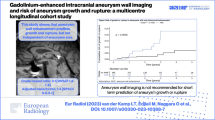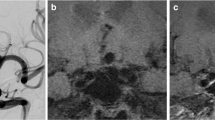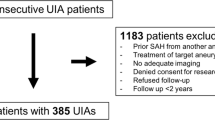Abstract
Background
The natural history, including growth and rupture, of unruptured intracranial aneurysms (UIAs) remains unknown. Here, we present the results of serial magnetic resonance angiography (MRA) follow-up study in 111 patients with 136 UIAs.
Method
A total of 111 patients with 136 UIAs were followed annually over the past 12 years, using 1.5-Tesla MRA. Follow-up was ended when UIAs were treated surgically, or the patients died of subarachnoid hemorrhage or other causes. Various factors influencing aneurysm rupture or growth were examined statistically.
Results
Aneurysm rupture and growth occurred in six and 13 of the 111 patients, respectively. Annual rupture rate was 1.8 % per year and annual growth rate was 3.9 % per year. Aneurysm size was the sole factor influencing rupture(H.R. 1.214, 95 % CI, 1.078–1.368) and multiplicity was the sole factor influencing aneurysm growth (H.R. 5.174, 95 % CI 1.81–14.80).
Conclusions
Serial MRA study showed that the incidence of UIA growth was twice as high as that of UIA rupture. As four patients showed aneurysm rupture or growth within 1 year, further investigations are necessary to determine the optimum interval of radiological investigation and to identify which UIAs grow or rupture within a short time.



Similar content being viewed by others
Abbreviations
- MRA:
-
Magnetic resonance angiography
- SAH:
-
Subarachnoid hemorrhage
- 3D-CTA:
-
Three-dimensional computed tomographic angiography
- UIAs:
-
Unruptured cerebral aneurysms
References
Burns JD, Huston J 3rd, Layton KF, Piepgras DG, Brown RD Jr (2009) Intracranial aneurysm enlargement on serial magnetic resonance angiography. Stroke 40:406–411
de Rooij NK, Linn FH, van der Plas JA, Algra A, Rinkel DJ (2007) Incidence of subarachnoid hemorrhage: a systematic review with emphasis on region, age, gender and time trends. J Neurol Neurosurg Psychiatry 78:1365–1372
Hiratsuka M, Miki H, Kiriyama I, Kikuchi K, Takahashi S, Matsubara I, Sadamoto K, Mochizuki T (2008) Diagnosis of unruptured intracranial aneurysms: 3T MR angiography versus 64-channel multi-detector row CT angiography. Magn Reson Med Sci 7:169–178
Hop JW, Rinkel GJ, Algra A, Van Gijn J (1997) Case-fatality rates and functional outcome after subarachnoid hemorrhage: a systematic review. Stroke 28:660–664
Imaizumi S, Onuma T, Motohashi O, Kameyama M (2002) Growth of small unruptured intracranial aneurysm: case report. Surg Neurol 58:155–156
Inagawa T, Takechi A, Yahara K, Saito J, Moritake K, Kobayashi S, Fujii Y, Sugimura C (2000) Primary intracerebral and aneurysmal subarachnoid hemorrhage in Izumo City, Japan. Part I: incidence and seasonal and diurnal variations. J Neurosurg 93(6):958–966
Juvela S, Porras M, Heiskanen O (1993) Natural history of unruptured intracranial aneurysms: a long term follow up study. J Neurosurg 79:174–182
Juvela S, Poussa K, Porras M (2001) Factors affecting formation and growth of intracranial aneurysms. A long-term follow up study. Stroke 32:485–491
Kozák N, Hayashi M (2007) Trends in the incidence of subarachnoid hemorrhage in Akita Prefecture, Japan. J Neurosurg 106:234–238
Matsubara S, Hadeishi H, Suzuki A, Yasui N, Nishimura H (2004) Incidence and risk factors for the growth of unruptured cerebral aneurysms: observation using serial computerized tomography angiography. J Neurosurg 101:908–914
Matsumoto K, Akagi K, Abekura M, Nakajima Y, Yoshimine T (2003) Investigation of the surgically treated and untreated unruptured cerebral aneurysms of the anterior circulation. Surg Neurol 60:516–523
Miyazawa N, Akiyama Y, Yamagata Z (2006) Risk factors for growth of unruptured intracranial aneurysms: Follow up study by serial 0.5-T magnetic resonance angiography. Neurosurgery 58:1047–1053
Morita A, Fujiwara S, Hashi K, Ohtsu H, Kirino T (2005) Risk of rupture associated with intact cerebral aneurysms in the Japanese population: a systematic review of the literature from Japan. J Neurosurg 102:601–606
Rinkel GJ, Djibuti M, Algra A, van Gjin J (1998) Prevalence and risk of rupture of intracranial aneurysms: a systematic review. Stroke 29:251–256
Rinne JK, Hernesiniemi JA (1993) De novo aneurysm: special multiple intracranial aneurysms. Neurosurgery 33:981–985
Suga M, Yamamoto Y, Sunami N, Abe T, Kondo A (2003) Growth of asymptomatic unruptured aneurysms in follow-up study: report of three cases. No Shinkei Geka 31:303–308
Sonobe M, Yamazaki T, Yonekura M, Kikuchi H (2010) Small unruptured cerebral aneurysm verification study (SUAVe study Japan). Stroke 41:1969–1977
The International Study of Unruptured Intracranial Aneurysms Investigators (1998) Unruptured intracranial aneurysms—risk of rupture and risks of surgical intervention. N Engl J Med 339:1725–1733
The International Study of Unruptured Intracranial Aneurysms Investigators (2003) Unruptured intracranial aneurysms: natural history, clinical outcome, and risks of surgical and endovascular treatment. Lancet 362:103–110
Tustumi K, Ueki K, Morita A, Usui M, Kirino T (2001) Risk of aneurysm recurrence in patients with clipped cerebral aneurysms. Results of long-term follow-up angiography. Stroke 32:1191–1194
Van der Sharf IC, Velthuis BK, Wermer MJH, Majoie C, Witkamp T, de Kort G, Freling NJ, Rinkel GJ, on behalf of the ASTRA study group (2005) New detected aneurysms on follow-up screening in patients with previously clipped intracranial aneurysms. Comparison with DSA or CTA at the time of SAH. Stroke 36:1753–1758
Yonekura M (2004) Small unruptured aneurysm verification (SUAVe Study Japan)—interim report. Neurol Med Chir (Tokyo) 44:213–214
Zamani A (1997) MRA of intracranial aneurysm. Clin Neurosci 4:123–129
Acknowledgment
The authors thanks Dr. Yohiharu Horie, Senior Statistician, Biostatistic Group of Nippon Boehringer Ingelheim Co. Ltd., for advice regarding statistical analyses.
Conflict of interest
None
Author information
Authors and Affiliations
Corresponding author
Rights and permissions
About this article
Cite this article
Matsumoto, K., Oshino, S., Sasaki, M. et al. Incidence of growth and rupture of unruptured intracranial aneurysms followed by serial MRA. Acta Neurochir 155, 211–216 (2013). https://doi.org/10.1007/s00701-012-1566-z
Received:
Accepted:
Published:
Issue Date:
DOI: https://doi.org/10.1007/s00701-012-1566-z




